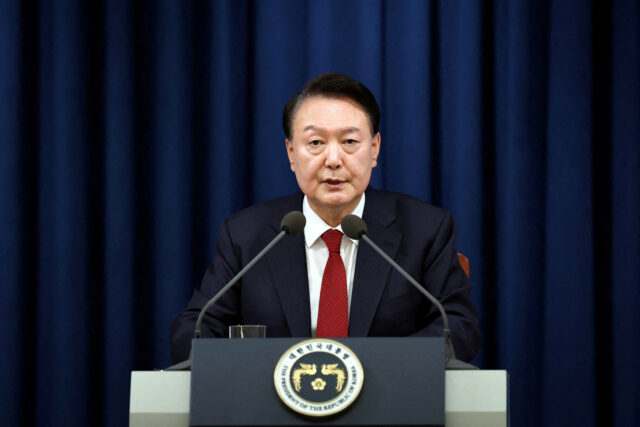By Luisa Maria Jacinta C. Jocson, Reporter
THE BANGKO SENTRAL ng Pilipinas (BSP) is expected to continue its rate-cutting cycle at its last policy review for the year on Thursday, analysts said.
A BusinessWorld poll conducted last week showed that 13 out of 16 analysts expect the Monetary Board to reduce the target reverse repurchase (RRP) rate by 25 basis points (bps) at its meeting on Dec. 19.
If realized, this would bring the benchmark rate to 5.75% from the current 6%.
 This would also mark the third straight meeting the central bank will cut rates since it began its easing cycle in August with a 25-bp cut. It trimmed borrowing costs by another 25 bps in October.
This would also mark the third straight meeting the central bank will cut rates since it began its easing cycle in August with a 25-bp cut. It trimmed borrowing costs by another 25 bps in October.
On the other hand, one analyst expects the central bank to cut by 50 bps, while two analysts see the BSP keeping policy rates unchanged on Thursday.
“We now expect the BSP to cut the RRP rate by 25 bps at their Dec. 19 policy meeting,” Bank of the Philippine Islands Lead Economist Emilio S. Neri, Jr. said.
“While a pause (or skip) remains possible, recent economic data and external developments have aligned in favor of monetary easing,” he added.
Analysts attributed the expectations of another rate cut to easing inflation and weaker-than-expected third-quarter gross domestic product (GDP) data.
“My forecast is for the BSP to cut by 25 bps to 5.75% next week. Factors for this decision are GDP growth and inflation trend and outlook,” Security Bank Vice-President and Research Division Head Angelo B. Taningco said.
“We expect BSP to cut the policy rate by 25 bps to 5.75% with the latest inflation data still well within its target and the outlook continues to be benign,” Nomura Global Markets Research analyst Euben Paracuelles said.
Headline inflation stood at 2.5% in November, bringing the 11-month average to 3.2%. This is still well within the BSP’s 2-4% target band.
The central bank expects inflation to settle at 3.1% this year.
“We think that it is ripe for the BSP to cut another 25 bps this December. Inflation staying within the BSP’s target is one of the main reasons why we think that the BSP will consider to cut,” Ruben Carlo O. Asuncion, chief economist at Union Bank of the Philippines, Inc., said.
Mr. Neri said the inflation outlook for next year also supports the case for a rate cut.
For next year, the BSP expects inflation to average 3.2%, still within target.
“Recent inflation prints have been at the lower end of the BSP’s 2-4% target range, and we estimate that inflation will remain firmly within target going forward,” Chinabank Research said.
SLOWING GROWTH
Slower-than-expected economic output may also prompt further easing, analysts said.
Chinabank Research said the BSP may be prompted to further ease policy to “provide an additional boost to the economy, especially on the investments side.”
“Members are likely to be persuaded to ease further in the wake of the weaker-than-expected third-quarter GDP print, which we rightly predicted would disappoint market expectations,” Pantheon Chief Emerging Asia Economist Miguel Chanco said.
The Philippine economy sharply slowed to 5.2% in the third quarter from 6.4% in the second quarter and 6% a year prior.
Economic growth averaged 5.8% in the first nine months, short of the government’s revised 6-6.5% target for the year.
“Recent Philippine economic activity data have fallen short of government and analyst expectations,” Mr. Neri said.
“Thus, while many other factors have dragged economic performance since the pandemic, pressure on government officials to deliver a rate cut continues to build, especially ahead of the midterm elections,” he added.
Expectations of the US Federal Reserve’s continued easing cycle will also make more room for the BSP’s own rate cuts.
“If the US Fed doesn’t deliver its own 25 bps (cut), we believe that the BSP will all the more consider cutting key interest rates,” Mr. Asuncion said.
Trader bets on the cut at the US central bank’s Dec. 17-18 meeting stand at near 97%, according to CME’s FedWatch Tool, Reuters reported.
“The latest US inflation report reinforced expectations of a 25-bp rate cut from the Fed (this) week,” Chinabank Research said.
“If realized, this would allow the BSP to cut rates again without adding downward pressure on the peso, since its interest rate differential with the Fed would remain at a comfortable 125 bps,” it added.
WEAK PESO
The peso may also be a consideration for the central bank’s next monetary policy decision.
“As for external factors, the more stable performance of the peso against the US dollar over the last couple of weeks may alleviate concerns about the transmission of exchange rate fluctuations to overall price behavior,” Mr. Neri said.
Oikonomia Advisory & Research, Inc. economist Reinielle Matt Erece said that the BSP will opt for an increment of 25 bps as “anything deeper can cause the peso to depreciate faster against the dollar especially if the Fed maintains its policy rate.”
The peso closed at P58.47 per dollar on Friday, weakening by 23 centavos from its P58.24 finish on Thursday.
Last month, the peso fell to the record-low P59-per-dollar level twice.
Moody’s Analytics economist Sarah Tan said that a weak peso could delay the BSP’s rate-cutting cycle.
“That said, policy easing remains likely as it would support private consumption, the primary driver of economic growth,” she added.
Meanwhile, Jonathan L. Ravelas, senior adviser at professional services firm Reyes Tacandong & Co., said there is room for the central bank to cut rates by 50 bps.
“With inflation at 2.5% in November, year-to-date at 3.2%, well within the BSP’s 2-4% target, they can cut by 50 bps to support growth following a slower growth in the third quarter,” he said.
“This will help ensure growth of at least 6.3%-6.5%. Fear of weakening currency as a result of cuts will improve the country’s competitiveness which will boost tourism, manufacturing support, business process outsourcing companies and overseas Filipino worker remittances,” he added.
Mr. Ravelas warned that it “might be difficult to cut rates next year as US President-elect Donald J. Trump assumes office.”
On the other hand, some analysts see the possibility of a policy hold on Thursday.
Ser Percival K. Peña-Reyes, director of the Ateneo de Manila University Center for Economic Research and Development, said the BSP will likely pause its easing cycle and keep its policy rate unchanged.
“I forecast that the Monetary Board will maintain its current policy rate. This is brought about by several factors like the fluctuating prices of oil, electricity and the depreciating value of the local currency against the dollar,” Emmanuel J. Lopez, professorial lecturer at the University of Santo Tomas Graduate School, said.
“Despite the slowdown in inflation, consumer products remain volatile in anticipation of the holidays, where demand pushes the prices at an upward trend,” he added.
2025 OUTLOOK
Meanwhile, analysts expect the BSP to continue cutting rates next year.
“For 2025, we forecast a 100-bp total cut and will be likely spread out once a quarter,” Patrick M. Ella, economist at Sun Life Investment Management and Trust Corp., said.
In a report, Capital Economics said it expects 100 bps worth of cuts in 2025 as growth is likely to moderate and inflation is seen to remain low. This will bring the policy rate to 4.75% at the end of 2025.
This is in line with signals by BSP Governor Eli M. Remolona, Jr., who said the Monetary Board can deliver rate cuts in the 100-bp range next year.
However, he said the BSP may not necessarily cut at every meeting or every quarter.
“The BSP may cut its rates further in 2025, as local economic data may remain supportive,” Mr. Neri said.
On the other hand, he said external shocks could “cap the extent of rate reductions.”
“If President Donald Trump delivers on his campaign promises of massive tariffs and deportation, higher US inflation could translate to slower US rate cuts, if not outright policy reversals,” Mr. Neri said.
Mr. Ella said there is a “small possibility” the BSP will pause rate cuts if the Fed also decides to halt its policy easing.
“But, at this point, we see this as a low probability event for BSP, perhaps a 10% chance of happening but this should change if there are key developments and if official BSP language/communications indicate otherwise,” he added.










 “We’re proud to share a piece of home on such a grand stage,” said Xander Lao, CEB President and Chief Commercial Officer. “This is a celebration of Philippine pride and an invitation for travelers to connect with the unique beauty, culture, and warmth that our country offers.”
“We’re proud to share a piece of home on such a grand stage,” said Xander Lao, CEB President and Chief Commercial Officer. “This is a celebration of Philippine pride and an invitation for travelers to connect with the unique beauty, culture, and warmth that our country offers.” Through this campaign, CEB aimed to invite travelers around the world to experience the wonders of the Philippines and offer Filipinos in the United Arab Emirates (UAE) a nostalgic view of home.
Through this campaign, CEB aimed to invite travelers around the world to experience the wonders of the Philippines and offer Filipinos in the United Arab Emirates (UAE) a nostalgic view of home. To bring this experience within reach to more passengers, CEB has also launched a special seat sale from Nov. 22 to 30, 2024. Passengers from major international hubs — including Hong Kong, Singapore, South Korea, Australia, and the Middle East — can now book discounted flights to the Philippines for travel in early 2025.
To bring this experience within reach to more passengers, CEB has also launched a special seat sale from Nov. 22 to 30, 2024. Passengers from major international hubs — including Hong Kong, Singapore, South Korea, Australia, and the Middle East — can now book discounted flights to the Philippines for travel in early 2025. CEB operates in over 60 destinations spanning Asia, Australia, and the Middle East. It operates the most extensive network in the Philippines, allowing for the best inter-island connections from hubs in Manila, Cebu, Clark, Iloilo and Davao.
CEB operates in over 60 destinations spanning Asia, Australia, and the Middle East. It operates the most extensive network in the Philippines, allowing for the best inter-island connections from hubs in Manila, Cebu, Clark, Iloilo and Davao.







